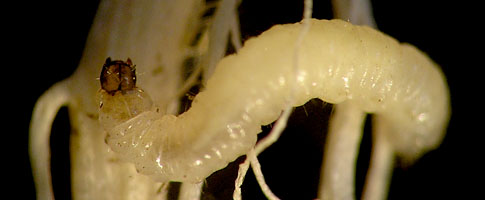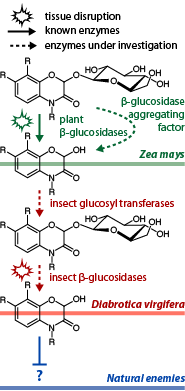Sugar wars

Sugar wars: Glucose-mediated activation, neutralization and re-activation of defensive metabolites in a soil tritrophic system
A new collaborative Sinergia project (start October 2015) has been granted to a consortium comprising Ted Turlings, Felix Kessler and two external partners, Matthias Erb (UniBE) and Jonathan Gershenzon (MPI Jena). The study will investigate gluco-modulation in a soil tritrophic system comprising maize plants, the western corn rootworm Diabrotica virgifera (WCR) and its natural enemies, such as entomopathogenic nematodes. It builds largely on the results of the previous Sinergia project dealing with benzoxazinoid derivatives at the plant-insect interface (end September 2015; see below).
 Activation of secondary metabolites by de-glycosylation is a widespread anti-herbivore defence strategy allowing plants to store harmless glycosides and hydrolyze them to toxic products upon attack. However, various specialized herbivores can re-glycosylate the activated toxins and store them for self-defence. The study seeks to achieve a detailed understanding of the biochemical mechanisms behind this phenomenon and of its ecological consequences. The main insect resistance factors in maize roots are benzoxazinoids (BXDs; see scheme to the left), which are stored as glucosides and activated by plant ß-glucosidases. Specialized WCR larvae are fully tolerant to BXDs and accumulate stabilized BXD glycosides upon BXD ingestion. Larval tissue disruption results in the rapid re-activation by putative insect ß-glucosidases, which is associated with increased resistance against natural enemies. Using an interdisciplinary approach which combines analytical chemistry, biochemistry, molecular physiology and ecology, the project will identify and characterize BXD glyco-modulation enzymes in maize and WCR, manipulate them using reverse genetics and investigate their role in tritrophic interactions below ground.
Activation of secondary metabolites by de-glycosylation is a widespread anti-herbivore defence strategy allowing plants to store harmless glycosides and hydrolyze them to toxic products upon attack. However, various specialized herbivores can re-glycosylate the activated toxins and store them for self-defence. The study seeks to achieve a detailed understanding of the biochemical mechanisms behind this phenomenon and of its ecological consequences. The main insect resistance factors in maize roots are benzoxazinoids (BXDs; see scheme to the left), which are stored as glucosides and activated by plant ß-glucosidases. Specialized WCR larvae are fully tolerant to BXDs and accumulate stabilized BXD glycosides upon BXD ingestion. Larval tissue disruption results in the rapid re-activation by putative insect ß-glucosidases, which is associated with increased resistance against natural enemies. Using an interdisciplinary approach which combines analytical chemistry, biochemistry, molecular physiology and ecology, the project will identify and characterize BXD glyco-modulation enzymes in maize and WCR, manipulate them using reverse genetics and investigate their role in tritrophic interactions below ground.
Benzoxazinoids at the plant-insect interface
Plants defend themselves against herbivores by producing repellent, toxic or inhibitory secondary metabolites. Specialized insects in turn have evolved mechanisms to counteract these plant defences. We study a major class of defensive secondary metabolites in maize plants, the benzoxazinoid derivatives. We investigate how the production of these metabolites increases in the plant upon herbivore attack and how they are detoxified by insect herbivores. Laboratory feeding experiments on whole plants, as well as on benzoxazinoids purified from plant tissue, reveal toxic and behavioral effects on the insects. Field experiments further investigate the relevance of these defence compounds for pest control and maize yield.




